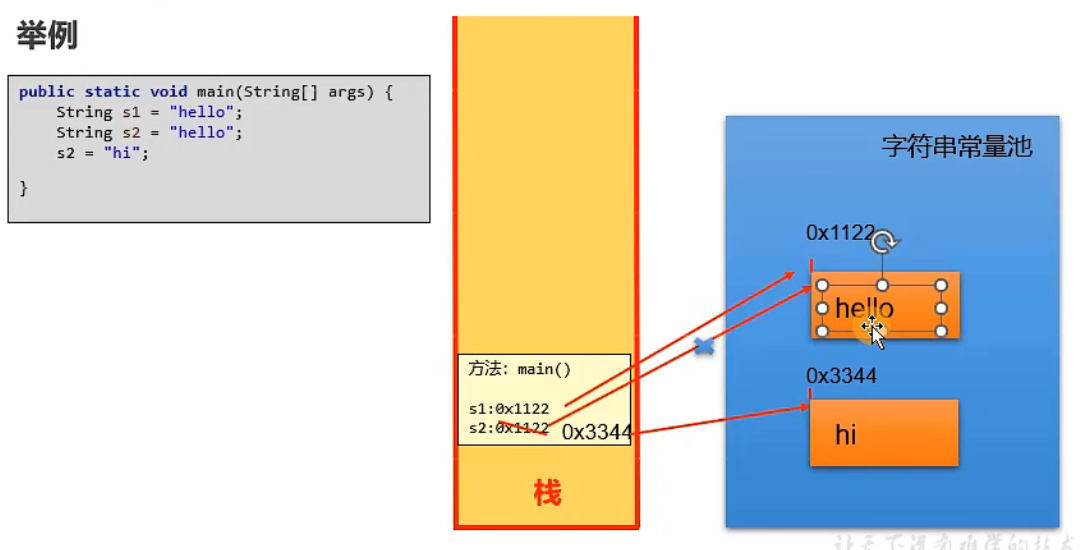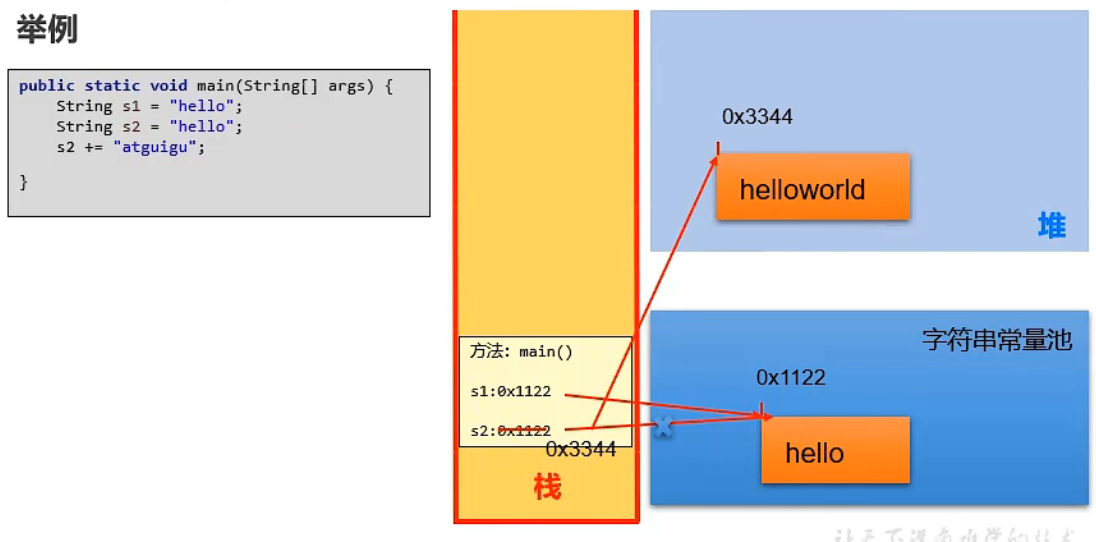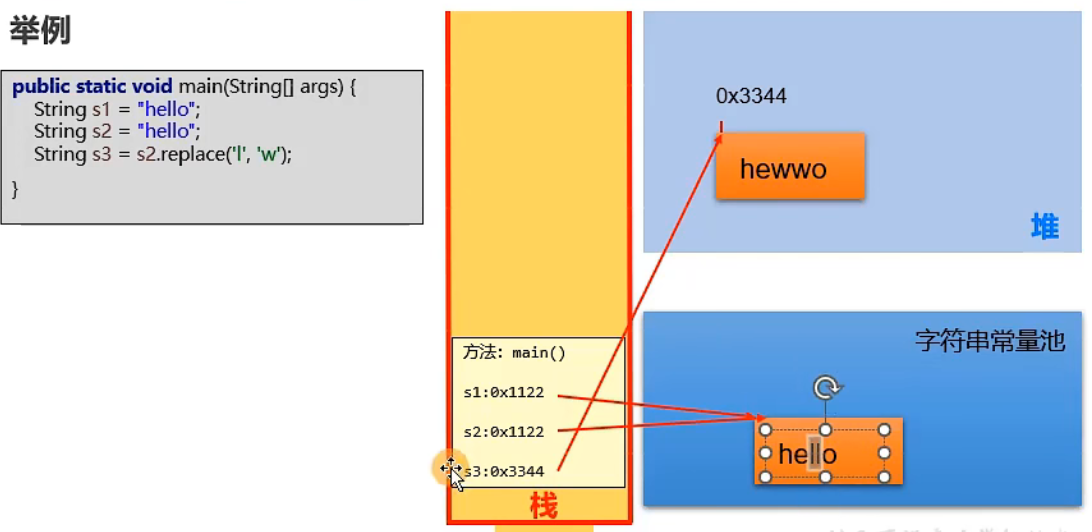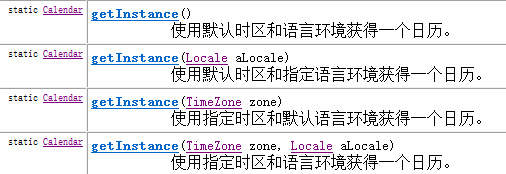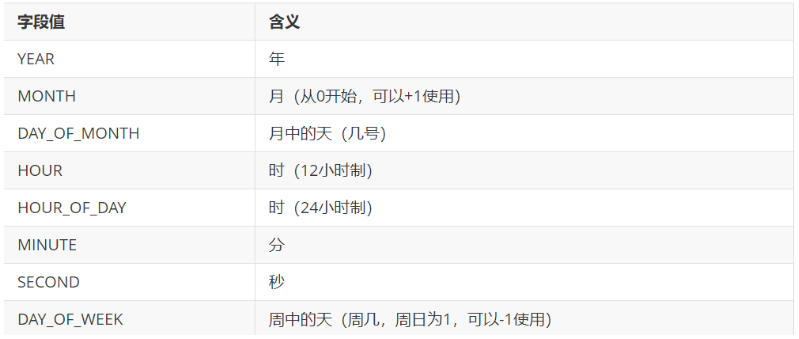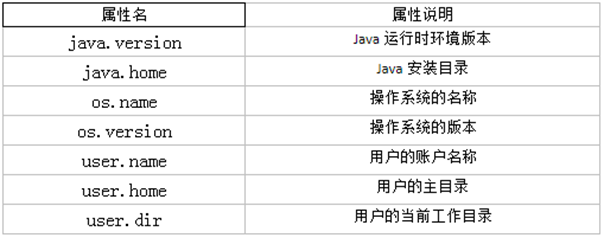# 第 11 章_常用类和基础 API
讲师:尚硅谷 - 宋红康(江湖人称:康师傅)
官网:http://www.atguigu.com
# 本章专题与脉络
主线:
- 字符串相关:String、StringBuffer、StringBuilder
- 日期时间相关:JDK8 前后
- 比较器的接口:java.lang.Comparable、java.util.Comparator
- 系统相关:System、Runtime
- 数学相关:Math、math 包、Random

# 1. String:字符串相关类之不可变字符序列
# 1.1 String 的特性
# 1.1.1 源码分析
//jdk8 中的 String 源码: | |
public final class String | |
implements java.io.Serializable, Comparable<String>, CharSequence { | |
/** The value is used for character storage. */ | |
private final char value[]; //String 对象的字符内容是存储在此数组中 | |
/** Cache the hash code for the string */ | |
private int hash; // Default to 0 |
java.lang.String类代表字符串。Java 程序中所有的字符串文字(例如"hello")都可以看作是实现此类的实例。final:字符串 String 类型本身是 final 声明的,意味着我们不能继承 String。
Serializable接口:可序列化,凡是实现了该接口的类的实例对象,就可以通过网络 / 本地流进行数据传输。
Comparable接口:凡是实现了该接口的类的实例对象,可以互相比较大小。
字符串是常量,它们的值在创建之后不能更改。
String 对象的字符内容是存储在 ** 一个 char 型数组 value []** 中的。
"hello"等效于char[] data={'h','e','l','l','o'}。![image-20220514184404024]()
private:意味着外面无法直接获取字符数组,而且 String 没有提供 value 的 get 和 set 方法。
final:意味着字符数组的引用不可改变,而且 String 也没有提供方法来修改 value 数组某个元素值。因此字符串的字符数组内容也不可变的,即String 代表着不可变的字符序列。即,一旦对字符串进行修改,就会产生新对象。
JDK9 开始,底层使用 byte [] 数组,这样可以节省内存空间,因为 byte 占 1 字节,而 char 占 2 字节。
public final class String implements java.io.Serializable, Comparable<String>, CharSequence {
@Stableprivate final byte[] value;
}// 官方说明:... that most String objects contain only Latin-1 characters. Such characters require only one byte of storage, hence half of the space in the internal char arrays of such String objects is going unused.// 细节:... The new String class will store characters encoded either as ISO-8859-1/Latin-1 (one byte per character), or as UTF-16 (two bytes per character), based upon the contents of the string. The encoding flag will indicate which encoding is used.
Java 语言提供对字符串串联符号("+")以及将其他对象转换为字符串的特殊支持(toString () 方法)。
# 1.1.2 字符串常量池
字符串常量池(StringTable):
因为字符串对象设计为不可变,那么所以字符串有常量池来保存很多常量对象。
不允许存放两个相同的字符串常量。
意味着相同的字符串常量,其地址相同:
String s1 = "abc";
String s2 = "abc";
System.out.println(s1 == s2); // true
输出为 true
所在位置:
变动与
静态变量域一致JDK6 中,字符串常量池在方法区。
JDK7 开始,就移到堆空间,直到目前 JDK17 版本。
堆空间中有 GC,能够及时回收字符串常量池的内存空间
# 1.1.3 String 的不可变性
当对字符串重新赋值时,需要重新指定一个字符串常量池中的地址值,不能修改原有的地址值
String s1 = "abc";
String s2 = "abc";
s2 = "hi";
System.out.println(s1); // abc
![image-20230316205324938]()
当对现有的字符串进行连接操作时(有变量参与),需要在堆空间中重新开辟一个空间,不能修改原有的地址值
String s1 = "abc";
String s2 = "abc";
s2 += "def";
System.out.println(s1); // abc
![image-20230316210008922]()
当调用 String 的replace()方法修改指定字符或字符串时,也需要在 **堆空间** 中重新开辟一个空间,不能修改原有的地址值
String s1 = "abc";
String s2 = "abc";
String s3 = s2.replace('a', 'm');
System.out.println(s1); // abc
System.out.println(s2); // abc
System.out.println(s3); // mbc
![image-20230316210226240]()
例题:
// 考察:方法参数的值传递机制、String 的不可变性 | |
public class excise1 { | |
String str = "good"; // 成员变量 str 指向 字符串常量池 中的 "good" | |
char[] ch = {'t', 'e', 's', 't'}; // 成员变量 ch 指向 堆空间 中的一个 char 数组 | |
public void change(String str, char ch[]) { | |
str = "test ok"; // 注意这里的 str 是形参,不是类的成员变量 this.str,所以不会改变 this.str | |
ch[0] = 'b'; // 传进来的 ch 指向的是堆空间中的一个 char 数组,所以会改变 this.ch | |
} | |
public static void main(String[] args) { | |
excise1 ex = new excise1(); | |
ex.change(ex.str, ex.ch); | |
System.out.println(ex.str); //good,因为 String 是不可变的,所以不会改变 | |
System.out.println(ex.ch); // best | |
} | |
} |
# 1.1.4 String 的实例化方式
字面量:在字符串常量池中
String s1 = "hello";
new 对象:在堆空间中
String s2 = new String("hello");
面试题:语句
String s2 = new String("hello");在内存中创建了几个对象?这条语句会在内存中创建两个对象。
字符串常量"hello",它会在字符串常量池中创建,因为该字符串常量已经存在于常量池中,所以不会创建新的对象。
通过 new 操作符创建的String 对象,它会在堆内存中创建。这个 String 对象的值为 "hello",它是通过调用 String 类的带参构造方法创建的,该构造方法会在堆内存中创建一个新的字符串对象。

举例:
String s1 = "hello"; | |
String s2 = "hello"; | |
String s3 = new String("hello"); | |
String s4 = new String("hello"); | |
System.out.println(s1 == s2); //true,因为 s1 和 s2 都指向了字符串常量池中的同一地址值 | |
System.out.println(s1 == s3); //false,因为 s1 指向了字符串常量池中的地址值,而 s3 指向了堆空间中的地址值 | |
System.out.println(s3 == s4); //false,因为 s3 和 s4 都指向了堆空间中的不同地址值 | |
System.out.println(s1.equals(s3)); //true,因为 String 类重写了 Object 类中的 equals () 方法,比较的是字符串的内容 |

# 1.2 String 的内存结构
# 1.2.1 概述
举例内存结构分配:

# 1.2.2 练习类型 1:字面量
String s1 = "hello"; | |
String s2 = "hello"; | |
System.out.println(s1 == s2); // true | |
// 字符串常量池中只有一个 "hello" 对象被创建,同时被 s1 和 s2 共享。 |
对应内存结构为:(以下内存结构以 JDK6为例 绘制):

进一步:

Person p1 = new Person(); | |
p1.name = "Tom"; | |
Person p2 = new Person(); | |
p2.name = "Tom"; | |
System.out.println(p1.name.equals(p2.name)); //true | |
System.out.println(p1.name == p2.name); //true | |
System.out.println(p1.name == "Tom"); //true |

# 1.2.3 练习类型 2:new
String str1 = “abc”; 与 String str2 = new String(“abc”); 的区别?

str2 首先指向堆中的一个 String对象 ,然后堆中字符串的 value 数组指向常量池中 常量对象 的 value 数组。
字符串常量存储在字符串常量池,目的是共享。
字符串非常量对象存储在堆中。
练习:
String s1 = "javaEE"; | |
String s2 = "javaEE"; | |
String s3 = new String("javaEE"); | |
String s4 = new String("javaEE"); | |
System.out.println(s1 == s2);//true | |
System.out.println(s1 == s3);//false | |
System.out.println(s1 == s4);//false | |
System.out.println(s3 == s4);//false |

练习: String str2 = new String("hello"); 在内存中创建了几个对象?
两个:
字符串常量"hello",它会在字符串常量池中创建,因为该字符串常量已经存在于常量池中,所以不会创建新的对象。
通过 new 操作符创建的String 对象,它会在堆内存中创建。这个 String 对象的值为 "hello",它是通过调用 String 类的带参构造方法创建的,该构造方法会在堆内存中创建一个新的字符串对象。
# 1.2.4 练习类型 3:拼接
- String s1 = "a";
说明:在字符串常量池中创建了一个字面量为 "a" 的字符串。
- s1 = s1 + "b";
说明:实际上原来的 “a” 字符串对象已经丢弃了,现在在堆空间中产生了一个字符串 s1+"b"(也就是 "ab")。如果多次执行这些改变串内容的操作,会导致大量副本字符串对象存留在内存中,降低效率。如果这样的操作放到循环中,会极大影响程序的性能。
- String s2 = "ab";
说明:直接在字符串常量池中创建一个字面量为 "ab" 的字符串。
- String s3 = "a" + "b";
说明:s3 指向字符串常量池中已经创建的 "ab" 的字符串。
- String s4 = s1.intern();
说明:堆空间的 s1 对象在调用 intern () 之后,会将常量池中已经存在的 "ab" 字符串赋值给 s4。
练习:
String s1 = "hello"; | |
String s2 = "world"; | |
String s3 = "helloworld"; | |
String s4 = "hello" + "world"; | |
String s5 = s1 + "world"; // 调用了 StringBuilder 的 toString ()->new String (),因此 s5 指向了堆空间中的地址值 | |
String s6 = "hello" + s2; // 同上 | |
String s7 = s1 + s2; // 同上 | |
System.out.println(s3 == s4); //true,因为 s3 和 s4 都指向了字符串常量池中的同一地址值 | |
System.out.println(s3 == s5); //false,因为 s3 指向了字符串常量池中的地址值,而 s5 指向了堆空间中的地址值 | |
System.out.println(s3 == s6); //false,因为 s3 指向了字符串常量池中的地址值,而 s6 指向了堆空间中的地址值 | |
System.out.println(s3 == s7); //false,因为 s3 指向了字符串常量池中的地址值,而 s7 指向了堆空间中的地址值 | |
System.out.println(s5 == s6); //false,因为 s5 和 s6 都指向了堆空间中的不同地址值 | |
System.out.println(s5 == s7); //false,因为 s5 和 s7 都指向了堆空间中的不同地址值 | |
System.out.println(); | |
String s8 = s5.intern(); //intern ():返回的是字符串常量池中对应字面量的地址值 | |
System.out.println(s3 == s8); //true,因为 s3 和 s8 都指向了字符串常量池中的同一地址值 |
结论:
常量 + 常量:结果存储在常量池中,返回此字面量的地址。且常量池中不会存在相同内容的常量。
这里的常量有两种情况:
- 字面量
- final 修饰的常量
常量 + 变量 或 变量 + 变量:结果 new 在堆中,返回堆空间中此字符串对象的地址。
如果变量声明为 final,那么就变成常量了!对应的情况就是 “常量 + 常量”
拼接后调用 intern ():返回常量池中字面量的地址。
concat () 拼接:哪怕是两个常量对象拼接,结果也是 new 在堆空间中。
练习:
@Test | |
public void test01(){ | |
String s1 = "hello"; | |
String s2 = "world"; | |
String s3 = "helloworld"; | |
String s4 = s1 + "world";//s4 字符串内容也 helloworld,s1 是变量,"world" 常量,变量 + 常量的结果在堆中 | |
String s5 = s1 + s2;//s5 字符串内容也 helloworld,s1 和 s2 都是变量,变量 + 变量的结果在堆中 | |
String s6 = "hello" + "world";// 常量 + 常量 结果在常量池中,因为编译期间就可以确定结果 | |
System.out.println(s3 == s4);//false | |
System.out.println(s3 == s5);//false | |
System.out.println(s3 == s6);//true | |
} | |
@Test | |
public void test02(){ | |
final String s1 = "hello"; | |
final String s2 = "world"; | |
String s3 = "helloworld"; | |
String s4 = s1 + "world";//s4 字符串内容也 helloworld,s1 是常量,"world" 常量,常量 + 常量结果在常量池中 | |
String s5 = s1 + s2;//s5 字符串内容也 helloworld,s1 和 s2 都是常量,常量 + 常量 结果在常量池中 | |
String s6 = "hello" + "world";// 常量 + 常量 结果在常量池中,因为编译期间就可以确定结果 | |
System.out.println(s3 == s4);//true | |
System.out.println(s3 == s5);//true | |
System.out.println(s3 == s6);//true | |
} | |
@Test | |
public void test01(){ | |
String s1 = "hello"; | |
String s2 = "world"; | |
String s3 = "helloworld"; | |
String s4 = (s1 + "world").intern();// 把拼接的结果放到常量池中 | |
String s5 = (s1 + s2).intern(); | |
System.out.println(s3 == s4);//true | |
System.out.println(s3 == s5);//true | |
} |
练习:下列程序运行的结果:
public class TestString { | |
public static void main(String[] args) { | |
String str = "hello"; | |
String str2 = "world"; | |
String str3 ="helloworld"; | |
String str4 = "hello".concat("world"); | |
String str5 = "hello"+"world"; | |
System.out.println(str3 == str4);//false | |
System.out.println(str3 == str5);//true | |
} | |
} |
concat()拼接,哪怕是两个常量对象拼接,结果也是在 **堆**。
练习:下列程序运行的结果:
public class StringTest { | |
String str = new String("good"); | |
char[] ch = { 't', 'e', 's', 't' }; | |
public void change(String str, char ch[]) { | |
str = "test ok"; | |
ch[0] = 'b'; | |
} | |
public static void main(String[] args) { | |
StringTest ex = new StringTest(); | |
ex.change(ex.str, ex.ch); | |
System.out.print(ex.str + " and ");// | |
System.out.println(ex.ch); | |
} | |
} |
# 1.3 String 的常用 API-1
# 1.3.1 构造器
public String():初始化新创建的 String 对象,以使其表示空字符序列。public String(String original): 初始化一个新创建的String对象,使其表示一个与参数相同的字符序列;换句话说,新创建的字符串是该参数字符串的副本。public String(char[] value):通过当前参数中的字符数组来构造新的 String。public String(char[] value,int offset, int count):通过字符数组的一部分来构造新的 String。public String(byte[] bytes):通过使用平台的默认字符集解码当前参数中的字节数组来构造新的 String。public String(byte[] bytes,String charsetName):通过使用 **指定的字符集**解码当前参数中的字节数组来构造新的 String。
举例:
// 字面量定义方式:字符串常量对象 | |
String str = "hello"; | |
// 构造器定义方式:无参构造 | |
String str1 = new String(); | |
// 构造器定义方式:创建 "hello" 字符串常量的副本 | |
String str2 = new String("hello"); | |
// 构造器定义方式:通过字符数组构造 | |
char chars[] = {'a', 'b', 'c','d','e'}; | |
String str3 = new String(chars); | |
String str4 = new String(chars,0,3); | |
// 构造器定义方式:通过字节数组构造 | |
byte bytes[] = {97, 98, 99 }; | |
String str5 = new String(bytes); | |
String str6 = new String(bytes,"GBK"); |
public static void main(String[] args) { | |
char[] data = {'h','e','l','l','o','j','a','v','a'}; | |
String s1 = String.copyValueOf(data); | |
String s2 = String.copyValueOf(data,0,5); | |
int num = 123456; | |
String s3 = String.valueOf(num); | |
System.out.println(s1); | |
System.out.println(s2); | |
System.out.println(s3); | |
} |
# 1.3.2 String 与其他结构间的转换
字符串 --> 基本数据类型、包装类:
- Integer 包装类的 public static int parseInt(String s):可以将由 “数字” 字符组成的字符串转换为整型。
- 类似地,使用 java.lang 包中的 Byte、Short、Long、Float、Double 类调相应的类方法可以将由 “数字” 字符组成的字符串,转化为相应的基本数据类型。
基本数据类型、包装类 --> 字符串:
- 调用 String 类的 public String valueOf(int n) 可将 int 型转换为字符串
- 相应的 valueOf (byte b)、valueOf (long l)、valueOf (float f)、valueOf (double d)、valueOf (boolean b) 可由参数的相应类型到字符串的转换。
字符数组 --> 字符串:
- String 类的构造器:String (char []) 和 String (char [],int offset,int length) 分别用字符数组中的全部字符和部分字符创建字符串对象。
字符串 --> 字符数组:
public char[] toCharArray():将字符串中的全部字符存放在一个字符数组中的方法。
public void getChars(int srcBegin, int srcEnd, char [] dst, int dstBegin):提供了将指定索引范围内的字符串存放到数组中的方法。
字符串 --> 字节数组:(编码)
- public byte[] getBytes() :使用平台的默认字符集将此 String 编码为 byte 序列,并将结果存储到一个新的 byte 数组中。
- public byte [] getBytes (String charsetName) :使用指定的字符集将此 String 编码到 byte 序列,并将结果存储到新的 byte 数组。
字节数组 --> 字符串:(解码)
- String (byte []):通过使用平台的默认字符集解码指定的 byte 数组,构造一个新的 String。
- String (byte [],int offset,int length) :用指定的字节数组的一部分,即从数组起始位置 offset 开始取 length 个字节构造一个字符串对象。
- String (byte [], String charsetName ) 或 new String (byte [], int, int,String charsetName ):解码,按照指定的编码方式进行解码。
代码示例:
@Test | |
public void test01() throws Exception { | |
String str = "中国"; | |
System.out.println(str.getBytes("ISO8859-1").length);// 2 | |
// ISO8859-1 把所有的字符都当做一个 byte 处理,处理不了多个字节 | |
System.out.println(str.getBytes("GBK").length);// 4 每一个中文都是对应 2 个字节 | |
System.out.println(str.getBytes("UTF-8").length);// 6 常规的中文都是 3 个字节 | |
/* | |
* 不乱码:(1)保证编码与解码的字符集名称一样(2)不缺字节 | |
*/ | |
System.out.println(new String(str.getBytes("ISO8859-1"), "ISO8859-1"));// 乱码 | |
System.out.println(new String(str.getBytes("GBK"), "GBK"));// 中国 | |
System.out.println(new String(str.getBytes("UTF-8"), "UTF-8"));// 中国 | |
} |
# 1.4 String 的常用 API-2
String 类包括的方法可用于检查序列的单个字符、比较字符串、搜索字符串、提取子字符串、创建字符串副本并将所有字符全部转换为大写或小写。
# 1.4.1 系列 1:常用方法
(1)boolean isEmpty ():字符串是否为空
(2)int length():返回字符串的长度
长度居然是方法,而不是成员变量属性
(3)String concat (xx):拼接
(4)boolean equals (Object obj):比较字符串是否相等,区分大小写
(5)boolean equalsIgnoreCase (Object obj):比较字符串是否相等,不区分大小写
(6)int compareTo(String other):比较字符串大小,区分大小写,按照 Unicode 编码值比较大小
(7)int compareToIgnoreCase (String other):比较字符串大小,不区分大小写
(8)String toLowerCase ():将字符串中大写字母转为小写
(9)String toUpperCase ():将字符串中小写字母转为大写
(10)String trim():去掉字符串前后空白符
(11)public String intern():结果在常量池中共享
@Test | |
public void test01(){ | |
// 将用户输入的单词全部转为小写,如果用户没有输入单词,重新输入 | |
Scanner input = new Scanner(System.in); | |
String word; | |
while(true){ | |
System.out.print("请输入单词:"); | |
word = input.nextLine(); | |
if(word.trim().length()!=0){ | |
word = word.toLowerCase(); | |
break; | |
} | |
} | |
System.out.println(word); | |
} | |
@Test | |
public void test02(){ | |
// 随机生成验证码,验证码由 0-9,A-Z,a-z 的字符组成 | |
char[] array = new char[26*2+10]; | |
for (int i = 0; i < 10; i++) { | |
array[i] = (char)('0' + i); | |
} | |
for (int i = 10,j=0; i < 10+26; i++,j++) { | |
array[i] = (char)('A' + j); | |
} | |
for (int i = 10+26,j=0; i < array.length; i++,j++) { | |
array[i] = (char)('a' + j); | |
} | |
String code = ""; | |
Random rand = new Random(); | |
for (int i = 0; i < 4; i++) { | |
code += array[rand.nextInt(array.length)]; | |
} | |
System.out.println("验证码:" + code); | |
// 将用户输入的单词全部转为小写,如果用户没有输入单词,重新输入 | |
Scanner input = new Scanner(System.in); | |
System.out.print("请输入验证码:"); | |
String inputCode = input.nextLine(); | |
if(!code.equalsIgnoreCase(inputCode)){ | |
System.out.println("验证码输入不正确"); | |
} | |
} |
# 1.4.2 系列 2:查找
(11)boolean contains(String str):是否包含 str
(12)int indexOf (String str):从前往后找当前字符串中 xx,即如果有返回第一次出现的下标,要是没有返回 - 1
(13)int indexOf (String str, int fromIndex):返回指定子字符串在此字符串中第一次出现处的索引,从指定的索引开始
(14)int lastIndexOf(xx):从后往前找当前字符串中 xx,即如果有返回最后一次出现的下标,要是没有返回 - 1
(15)int lastIndexOf (String str, int fromIndex):返回指定子字符串在此字符串中最后一次出现处的索引,从指定的索引开始反向搜索。
@Test | |
public void test01(){ | |
String str = "尚硅谷是一家靠谱的培训机构,尚硅谷可以说是IT培训的小清华,JavaEE是尚硅谷的当家学科,尚硅谷的大数据培训是行业独角兽。尚硅谷的前端和UI专业一样独领风骚。"; | |
System.out.println("是否包含清华:" + str.contains("清华")); | |
System.out.println("培训出现的第一次下标:" + str.indexOf("培训")); | |
System.out.println("培训出现的最后一次下标:" + str.lastIndexOf("培训")); | |
} |
# 1.4.3 系列 3:字符串截取
(16)String substring (int beginIndex) :返回一个新的字符串,它是此字符串的从 beginIndex 开始截取到最后的一个子字符串。
(17)String substring (int beginIndex, int endIndex) :返回一个新字符串,它是此字符串从 beginIndex 开始截取到 endIndex (不包含) 的一个子字符串。
@Test | |
public void test01(){ | |
String str = "helloworldjavaatguigu"; | |
String sub1 = str.substring(5); | |
String sub2 = str.substring(5,10); | |
System.out.println(sub1); | |
System.out.println(sub2); | |
} | |
@Test | |
public void test02(){ | |
String fileName = "快速学习Java的秘诀.dat"; | |
// 截取文件名 | |
System.out.println("文件名:" + fileName.substring(0,fileName.lastIndexOf("."))); | |
// 截取后缀名 | |
System.out.println("后缀名:" + fileName.substring(fileName.lastIndexOf("."))); | |
} |
# 1.4.4 系列 4:和字符 / 字符数组相关
(18)char charAt(int index):返回 [index] 位置的字符
String 不能像数组那样通过
[]访问字符,但是好在有 charAt () 方法
(19)char[] toCharArray(): 将此字符串转换为一个新的字符数组返回
(20)static String valueOf(char [] data) :返回指定数组中表示该字符序列的 String
(21)static String valueOf (char [] data, int offset, int count) : 返回指定数组中表示该字符序列的 String
(22)static String copyValueOf(char [] data): 返回指定数组中表示该字符序列的 String
(23)static String copyValueOf (char [] data, int offset, int count):返回指定数组中表示该字符序列的 String
@Test | |
public void test01(){ | |
// 将字符串中的字符按照大小顺序排列 | |
String str = "helloworldjavaatguigu"; | |
char[] array = str.toCharArray(); | |
Arrays.sort(array); | |
str = new String(array); | |
System.out.println(str); | |
} | |
@Test | |
public void test02(){ | |
// 将首字母转为大写 | |
String str = "jack"; | |
str = Character.toUpperCase(str.charAt(0))+str.substring(1); | |
System.out.println(str); | |
} | |
@Test | |
public void test03(){ | |
char[] data = {'h','e','l','l','o','j','a','v','a'}; | |
String s1 = String.copyValueOf(data); | |
String s2 = String.copyValueOf(data,0,5); | |
int num = 123456; | |
String s3 = String.valueOf(num); | |
System.out.println(s1); | |
System.out.println(s2); | |
System.out.println(s3); | |
} |
# 1.4.5 系列 5:开头与结尾
(24)boolean startsWith(String prefix):测试此字符串是否以指定的前缀开始
(25)boolean startsWith (String prefix, int offset):测试此字符串从指定索引开始的子字符串是否以指定前缀开始
(26)boolean endsWith(String postfix):测试此字符串是否以指定的后缀结束
@Test | |
public void test1(){ | |
String name = "张三"; | |
System.out.println(name.startsWith("张")); | |
} | |
@Test | |
public void test2(){ | |
String file = "Hello.txt"; | |
if(file.endsWith(".java")){ | |
System.out.println("Java源文件"); | |
}else if(file.endsWith(".class")){ | |
System.out.println("Java字节码文件"); | |
}else{ | |
System.out.println("其他文件"); | |
} | |
} |
# 1.4.6 系列 6:替换
(27)String replace(char oldChar, char newChar):返回一个 **新的** 字符串,但调用它的 String 对象不会变,它是通过用 newChar 替换此字符串中出现的所有 oldChar 得到的。 不支持正则。
(28)String replace (CharSequence target, CharSequence replacement):使用指定的字面值替换序列替换此字符串所有匹配字面值目标序列的子字符串。
(29)String replaceAll(String regex, String replacement):使用给定的 replacement 替换此字符串所有匹配给定的正则表达式的子字符串。
(30)String replaceFirst(String regex, String replacement):使用给定的 replacement 替换此字符串匹配给定的正则表达式的第一个子字符串。
@Test | |
public void test1(){ | |
String str1 = "hello244world.java;887"; | |
// 把其中的非字母去掉 | |
str1 = str1.replaceAll("[^a-zA-Z]", ""); | |
System.out.println(str1); | |
String str2 = "12hello34world5java7891mysql456"; | |
// 把字符串中的数字替换成,,如果结果中开头和结尾有,的话去掉 | |
String string = str2.replaceAll("\\d+", ",").replaceAll("^,|,$", ""); | |
System.out.println(string); | |
} |
# 1.5 常见算法题目
** 题目 1:** 模拟一个 trim 方法,去除字符串两端的空格。
public String myTrim(String str) { | |
// 特判:如果字符串为空,直接返回 | |
if (str == null) { | |
return null; | |
} | |
// 从两端开始遍历,遇到不是空格的字符就停止。 | |
int start = 0; | |
int end = str.length() - 1; | |
// 从左边开始遍历 | |
while (start <= end && str.charAt(start) == ' ') { | |
start++; | |
} | |
// 从右边开始遍历 | |
while (start <= end && str.charAt(end) == ' ') { | |
end--; | |
} | |
// 从 start 到 end 截取字符串 | |
return str.substring(start, end + 1); // 因为 substring 是左闭右开的,所以 end 要加 1 | |
} | |
@Test | |
public void testTrim() { | |
String str = " hello world "; | |
String str1 = myTrim(str); | |
System.out.println(str1); | |
} |
** 题目 2:** 将一个字符串进行反转。将字符串中指定部分进行反转。比如 “ab cdef g” 反转为”ab fedc g”
// 方式一:双指针法,将 String 转换为 char [],然后交换指定位置的字符,最后再转换为 String | |
private String myReverse1(String str, int start, int end) { | |
// 特判:如果字符串为空,直接返回 | |
if (str == null) { | |
return null; | |
} | |
// 特判:如果 start 和 end 不在字符串的范围内,直接返回 | |
if (start < 0 || end > str.length() - 1) { | |
return str; | |
} | |
// 将字符串转换为 char 数组 | |
char[] arr = str.toCharArray(); | |
// 双指针法,分别指向首尾,互相交换,向中间移动 | |
for (int i = start, j = end; i < j; i++, j--) { | |
char temp = arr[i]; | |
arr[i] = arr[j]; | |
arr[j] = temp; | |
} | |
// 将 char 数组转换为字符串 | |
return new String(arr); | |
} | |
// 方式二:字符串拼接法,每次 += 都会在堆空间中开辟一个新的 String 对象,效率低 | |
private String myReverse2(String str, int start, int end) { | |
// 特判:如果字符串为空,直接返回 | |
if (str == null) { | |
return null; | |
} | |
// 特判:如果 start 和 end 不在字符串的范围内,直接返回 | |
if (start < 0 || end > str.length() - 1) { | |
return str; | |
} | |
// 先从 0 到 start 截取字符串 | |
String resStr = str.substring(0, start); | |
// 再将 start 到 end 的字符串反转,拼接到 resStr 后面 | |
for (int i = end; i >= start; i--) { | |
resStr += str.charAt(i); // 每次 += 都会在堆空间中开辟一个新的 String 对象,效率低 | |
} | |
// 最后将 end 到字符串末尾的字符串拼接到 resStr 后面 | |
resStr += str.substring(end + 1); // 只有一个参数时,表示从该位置到字符串末尾 | |
return resStr; | |
} | |
// 方式三:针对方式二的优化,使用 StringBuffer,其 append () 方法不会开辟新的对象 | |
private String myReverse3(String str, int start, int end) { | |
// 特判:如果字符串为空,直接返回 | |
if (str == null) { | |
return null; | |
} | |
// 特判:如果 start 和 end 不在字符串的范围内,直接返回 | |
if (start < 0 || end > str.length() - 1) { | |
return str; | |
} | |
// 先创建一个 StringBuffer 对象,长度为字符串的长度 | |
StringBuffer sb = new StringBuffer(str.length()); | |
// 先从 0 到 start 截取字符串 | |
sb.append(str.substring(0, start)); | |
// 再将 start 到 end 的字符串反转,拼接到 resStr 后面 | |
for (int i = end; i >= start; i--) { | |
sb.append(str.charAt(i)); | |
} | |
// 最后将 end 到字符串末尾的字符串拼接到 resStr 后面 | |
sb.append(str.substring(end + 1)); | |
return sb.toString(); | |
} | |
@Test | |
public void testReverse() { | |
String str = "abcdefg"; | |
String str1 = myReverse3(str, 2, 5); | |
System.out.println(str1); | |
} |
** 题目 3:** 获取一个字符串在另一个字符串中出现的次数。
比如:获取 “ab” 在 “abkkcadkabkebfkabkskab” 中出现的次数
// 第 3 题 | |
// 判断 str2 在 str1 中出现的次数 | |
public int getCount(String mainStr, String subStr) { | |
if (mainStr.length() >= subStr.length()) { | |
int count = 0; | |
int index = 0; | |
// while((index = mainStr.indexOf(subStr)) != -1){ | |
// count++; | |
// mainStr = mainStr.substring(index + subStr.length()); | |
// } | |
// 改进: | |
while ((index = mainStr.indexOf(subStr, index)) != -1) { | |
index += subStr.length(); | |
count++; | |
} | |
return count; | |
} else { | |
return 0; | |
} | |
} | |
@Test | |
public void testGetCount() { | |
String str1 = "cdabkkcadkabkebfkabkskab"; | |
String str2 = "ab"; | |
int count = getCount(str1, str2); | |
System.out.println(count); | |
} |
** 题目 4:** 获取两个字符串中最大相同子串。比如:
str1 = "abcwerthelloyuiodef“;str2 = "cvhellobnm"
提示:将短的那个串进行长度依次递减的子串与较长的串比较。
// 第 4 题 | |
// 如果只存在一个最大长度的相同子串 | |
public String getMaxSameSubString(String str1, String str2) { | |
if (str1 != null && str2 != null) { | |
String maxStr = (str1.length() > str2.length()) ? str1 : str2; | |
String minStr = (str1.length() > str2.length()) ? str2 : str1; | |
int len = minStr.length(); | |
for (int i = 0; i < len; i++) {// 0 1 2 3 4 此层循环决定要去几个字符 | |
for (int x = 0, y = len - i; y <= len; x++, y++) { | |
if (maxStr.contains(minStr.substring(x, y))) { | |
return minStr.substring(x, y); | |
} | |
} | |
} | |
} | |
return null; | |
} | |
// 如果存在多个长度相同的最大相同子串 | |
// 此时先返回 String [],后面可以用集合中的 ArrayList 替换,较方便 | |
public String[] getMaxSameSubString1(String str1, String str2) { | |
if (str1 != null && str2 != null) { | |
StringBuffer sBuffer = new StringBuffer(); | |
String maxString = (str1.length() > str2.length()) ? str1 : str2; | |
String minString = (str1.length() > str2.length()) ? str2 : str1; | |
int len = minString.length(); | |
for (int i = 0; i < len; i++) { | |
for (int x = 0, y = len - i; y <= len; x++, y++) { | |
String subString = minString.substring(x, y); | |
if (maxString.contains(subString)) { | |
sBuffer.append(subString + ","); | |
} | |
} | |
System.out.println(sBuffer); | |
if (sBuffer.length() != 0) { | |
break; | |
} | |
} | |
String[] split = sBuffer.toString().replaceAll(",$", "").split("\\,"); | |
return split; | |
} | |
return null; | |
} | |
// 如果存在多个长度相同的最大相同子串:使用 ArrayList | |
// public List<String> getMaxSameSubString1(String str1, String str2) { | |
// if (str1 != null && str2 != null) { | |
// List<String> list = new ArrayList<String>(); | |
// String maxString = (str1.length() > str2.length()) ? str1 : str2; | |
// String minString = (str1.length() > str2.length()) ? str2 : str1; | |
// | |
// int len = minString.length(); | |
// for (int i = 0; i < len; i++) { | |
// for (int x = 0, y = len - i; y <= len; x++, y++) { | |
// String subString = minString.substring(x, y); | |
// if (maxString.contains(subString)) { | |
// list.add(subString); | |
// } | |
// } | |
// if (list.size() != 0) { | |
// break; | |
// } | |
// } | |
// return list; | |
// } | |
// | |
// return null; | |
// } | |
@Test | |
public void testGetMaxSameSubString() { | |
String str1 = "abcwerthelloyuiodef"; | |
String str2 = "cvhellobnmiodef"; | |
String[] strs = getMaxSameSubString1(str1, str2); | |
System.out.println(Arrays.toString(strs)); | |
} |
** 题目 5:** 对字符串中字符进行自然顺序排序。
提示:
1)字符串变成字符数组。
2)对数组排序,选择,冒泡,Arrays.sort ();
3)将排序后的数组变成字符串。
// 第 5 题 | |
@Test | |
public void testSort() { | |
String str = "abcwerthelloyuiodef"; | |
char[] arr = str.toCharArray(); | |
Arrays.sort(arr); | |
String newStr = new String(arr); | |
System.out.println(newStr); | |
} |
# 2. StringBuffer、StringBuilder:字符串相关类之可变字符序列
因为 String 对象是不可变对象,虽然可以共享常量对象,但是对于频繁字符串的修改和拼接操作,效率极低,空间消耗也比较高。
因此,JDK 又在 java.lang 包提供了可变字符序列 StringBuffer 和 StringBuilder 类型。
# 2.1 StringBuffer 与 StringBuilder 的理解
java.lang.StringBuffer 代表
可变的字符序列,JDK1.0 中声明,可以对字符串内容进行增删,此时不会产生新的对象。比如:// 情况 1:String s = new String("我喜欢学习");
// 情况 2:StringBuffer buffer = new StringBuffer("我喜欢学习");
buffer.append("数学");
![image-20220405221714261]()

- 继承结构:
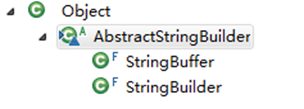

- StringBuilder 和 StringBuffer 非常类似,均代表可变的字符序列,而且提供相关功能的方法也一样。
# 对比 String、StringBuffer、StringBuilder
String
不可变的字符序列
private final char value[];
效率最低
底层使用char[]数组存储 (JDK8.0 中),底层使用 byte [] 数组存储(JDK9 及之后)
StringBuffer
可变的字符序列
char[] value;
JDK1.0 引入
线程安全(方法有 synchronized 修饰),因此效率比 StringBuilder 低
底层使用char[]数组存储 (JDK8.0 中),底层使用 byte [] 数组存储(JDK9 及之后)
StringBuilder:
可变的字符序列
char[] value;
jdk1.5 引入
线程不安全的,效率高
底层使用char[]数组存储 (JDK8.0 中),底层使用 byte [] 数组存储(JDK9 及之后)
# StringBuffer 与 StringBuilder 的联系
相同点
- 二者都继承于
AbstractStringBuilder抽象类 - 都是可变的字符序列
- 底层都使用char[]数组存储 (JDK8.0 中),底层都使用 byte [] 数组存储(JDK9 及之后)
- 二者都继承于
不同点
- StringBuffer 是线程安全的(因为方法都用 synchronized 修饰),也因此效率较低
# StringBuffer、StringBuilder 的可变性分析
String
String s1 = new String(); // final char[] value = new char[0];
String s2 = new String("abc"); // final char[] value = new char[]{'a','b','c'};
StringBuilder
- 内部属性
- char [] value:存储字符序列
- int count:实际存储的字符个数
StringBuilder sBuilder1 = new StringBuilder(); // char[] value = new char[16];
StringBuilder sBuilder2 = new StringBuilder("abc"); // char[] value = new char[16 + "abc".length()];
sBuilder1.append("ac"); // value[0]='a'; value[1]='c';
sBuilder1.append('b'); // value[2]='b';
// 不断添加... 一旦 count 超过 value.length (),就需要扩容(扩容为原来的 2 倍 + 2),// 然后将原来的 value 数组复制到新的 value 数组中。- 内部属性
# 开发启示
- 如果开发中,需要对字符串进行频繁的增、删、改操作,建议使用 StringBuffer、StringBuilder
- 如果开发中,不涉及多线程,建议使用 StringBuilder,因为效率更高
- 如果开发中,可以大体确定要操作的字符个数,建议使用带有 int capacity 参数的构造器,可以避免多次扩容,性能更优
# 2.2 StringBuilder、StringBuffer 的 API
StringBuilder、StringBuffer 的 API 是完全一致的,并且很多方法与 String 相同。
1、常用 API
- 增
(1)StringBuffer append(xx):提供了很多的 append () 方法,用于进行字符串追加的方式拼接
- 删
(2)StringBuffer delete(int start, int end):删除 [start,end) 之间字符
(3)StringBuffer deleteCharAt(int index):删除 [index] 位置字符
- 改
(4)StringBuffer replace(int start, int end, String str):替换 [start,end) 范围的字符序列为 str
(5)void setCharAt(int index, char c):替换 [index] 位置字符
- 查
(6)char charAt(int index):查找指定 index 位置上的字符
- 插入
(7)StringBuffer insert(int index, xx):在 [index] 位置插入 xx
- 长度
(8)int length():返回实际存储的字符数据的长度,即返回count
(9)StringBuffer reverse():反转
当 append 和 insert 时,如果原来 value 数组长度不够,可扩容。
如上 (1)(2)(3)(4)(9) 这些方法支持
方法链操作。原理:
2、其它 API
(1)int indexOf(String str):在当前字符序列中查询 str 的第一次出现下标
(2)int indexOf (String str, int fromIndex):在当前字符序列 [fromIndex, 最后] 中查询 str 的第一次出现下标
(3)int lastIndexOf(String str):在当前字符序列中查询 str 的最后一次出现下标
(4)int lastIndexOf (String str, int fromIndex):在当前字符序列 [fromIndex, 最后] 中查询 str 的最后一次出现下标
(5)String substring(int start):截取当前字符序列 [start, 最后]
(6)String substring (int start, int end):截取当前字符序列 [start,end)
(7)String toString():返回此序列中数据的字符串表示形式
(8)void setLength(int newLength) :
将count设置为 newLength
会截断(但不会改变 value 数组中的内容!)或者覆盖填充
但是任何对字符串的操作,都是从新设置的 count 进行了,而不是 value.length ()
@Test | |
public void test1(){ | |
StringBuilder s = new StringBuilder(); | |
s.append("hello").append(true).append('a').append(12).append("atguigu"); | |
System.out.println(s); | |
System.out.println(s.length()); | |
} | |
@Test | |
public void test2(){ | |
StringBuilder s = new StringBuilder("helloworld"); | |
s.insert(5, "java"); | |
s.insert(5, "chailinyan"); | |
System.out.println(s); | |
} | |
@Test | |
public void test3(){ | |
StringBuilder s = new StringBuilder("helloworld"); | |
s.delete(1, 3); | |
s.deleteCharAt(4); | |
System.out.println(s); | |
} | |
@Test | |
public void test4(){ | |
StringBuilder s = new StringBuilder("helloworld"); | |
s.reverse(); | |
System.out.println(s); | |
} | |
@Test | |
public void test5(){ | |
StringBuilder s = new StringBuilder("helloworld"); | |
s.setCharAt(2, 'a'); | |
System.out.println(s); | |
} | |
@Test | |
public void test6(){ | |
StringBuilder s = new StringBuilder("helloworld"); | |
s.setLength(30); | |
System.out.println(s); | |
} |
# 2.3 效率测试
从高到低:StringBuilder > StringBuffer > String
// 初始设置 | |
long startTime = 0L; | |
long endTime = 0L; | |
String text = ""; | |
StringBuffer buffer = new StringBuffer(""); | |
StringBuilder builder = new StringBuilder(""); | |
// 开始对比 | |
startTime = System.currentTimeMillis(); | |
for (int i = 0; i < 20000; i++) { | |
buffer.append(String.valueOf(i)); | |
} | |
endTime = System.currentTimeMillis(); | |
System.out.println("StringBuffer的执行时间:" + (endTime - startTime)); | |
startTime = System.currentTimeMillis(); | |
for (int i = 0; i < 20000; i++) { | |
builder.append(String.valueOf(i)); | |
} | |
endTime = System.currentTimeMillis(); | |
System.out.println("StringBuilder的执行时间:" + (endTime - startTime)); | |
startTime = System.currentTimeMillis(); | |
for (int i = 0; i < 20000; i++) { | |
text = text + i; | |
} | |
endTime = System.currentTimeMillis(); | |
System.out.println("String的执行时间:" + (endTime - startTime)); |

# 2.4 练习
笔试题:程序输出:
public void operate(StringBuffer x, StringBuffer y) { | |
x.append(y); | |
y = x; | |
y.append("x"); | |
} | |
@Test | |
public void testExcise() { | |
StringBuffer a = new StringBuffer("A"); | |
StringBuffer b = new StringBuffer("B"); | |
operate(a, b); | |
System.out.println(a + "," + b); // ABx,B | |
} |
String str = null; | |
StringBuffer sb = new StringBuffer(); // value = new char[16]; count = 0; | |
sb.append(str); //append () 方法中,如果 str 为 null,会将 "null" 添加到 value 数组中 | |
System.out.println(sb.length()); // 4 | |
System.out.println(sb);// "null" | |
StringBuffer sb1 = new StringBuffer(str); // 构造器中会访问 str.length (),所以会报空指针异常 | |
System.out.println(sb1);// |
# 3. JDK8 之前:日期时间 API
# 3.1 java.lang.System 类的方法
System 类提供的 public static long currentTimeMillis():用来返回当前时间与 1970 年 1 月 1 日 0 时 0 分 0 秒之间以毫秒为单位的时间差。
- 此方法适于计算时间差。
计算世界时间的主要标准有:
- UTC(Coordinated Universal Time)
- GMT(Greenwich Mean Time)
- CST(Central Standard Time)
在国际无线电通信场合,为了统一起见,使用一个统一的时间,称为通用协调时 (UTC, Universal Time Coordinated)。UTC 与格林尼治平均时 (GMT, Greenwich Mean Time) 一样,都与英国伦敦的本地时相同。这里,UTC 与 GMT 含义完全相同。
# 3.2 java.util.Date
有个子类
java.sql.Date,对应着数据库中的 Date 类型
表示特定的瞬间,精确到毫秒。
- 构造器:
- Date ():使用无参构造器创建的对象可以获取本地当前时间。
- Date (long 毫秒数):把该毫秒值换算成日期时间对象
- 方法
- getTime(): 返回自 1970 年 1 月 1 日 00:00:00 GMT 以来此 Date 对象表示的毫秒数。
- toString(): 把此 Date 对象转换为以下形式的 String: dow mon dd hh:mm:ss zzz yyyy 其中: dow 是一周中的某一天 (Sun, Mon, Tue, Wed, Thu, Fri, Sat),zzz 是时间标准。
- 其它很多方法都过时了。
- 举例:
@Test | |
public void test1(){ | |
Date d = new Date(); | |
System.out.println(d); | |
} | |
@Test | |
public void test2(){ | |
long time = System.currentTimeMillis(); | |
System.out.println(time);//1559806982971 | |
// 当前系统时间距离 1970-1-1 0:0:0 0 毫秒的时间差,毫秒为单位 | |
} | |
@Test | |
public void test3(){ | |
Date d = new Date(); | |
long time = d.getTime(); | |
System.out.println(time);//1559807047979 | |
} | |
@Test | |
public void test4(){ | |
long time = 1559807047979L; | |
Date d = new Date(time); | |
System.out.println(d); | |
} | |
@Test | |
public void test5(){ | |
long time = Long.MAX_VALUE; | |
Date d = new Date(time); | |
System.out.println(d); | |
} |
# 3.3 java.text.SimpleDateFormat
java.text.SimpleDateFormat类是一个与语言环境无关的方式来格式化和解析日期的具体类。- 构造器:
- SimpleDateFormat () :默认的模式和语言环境创建对象
- public SimpleDateFormat(String pattern):该构造方法可以用参数 pattern 指定的格式创建一个对象
- 格式化:日期 --> 文本
- public String format(Date date):方法格式化时间对象 date
- 解析:文本 --> 日期
- public Date parse(String source):从给定字符串的开始解析文本,以生成一个日期。
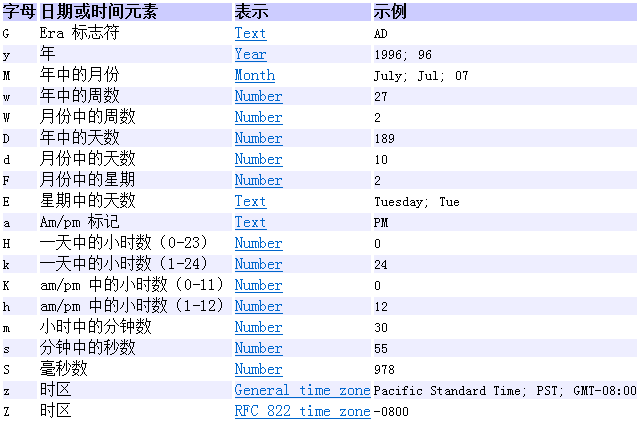
// 格式化 | |
@Test | |
public void test1(){ | |
Date d = new Date(); | |
SimpleDateFormat sf = new SimpleDateFormat("yyyy年MM月dd日 HH时mm分ss秒 SSS毫秒 E Z"); | |
// 把 Date 日期转成字符串,按照指定的格式转 | |
String str = sf.format(d); | |
System.out.println(str); | |
} | |
// 解析 | |
@Test | |
public void test2() throws ParseException{ | |
String str = "2022年06月06日 16时03分14秒 545毫秒 星期四 +0800"; | |
SimpleDateFormat sf = new SimpleDateFormat("yyyy年MM月dd日 HH时mm分ss秒 SSS毫秒 E Z"); | |
Date d = sf.parse(str); | |
System.out.println(d); | |
} |
# 3.4 java.util.Calendar (日历)

Date 类的 API 大部分被废弃了,替换为 Calendar。
Calendar类是一个抽象类,主用用于完成日期字段之间相互操作的功能。获取 Calendar 实例的方法
使用 Calendar.getInstance() 方法,获取的其实就是子类 GregorianCalendar(公历)的一个实例对象。
![image-20220123184906903]()
调用它的子类 GregorianCalendar(公历)的构造器。
![image-20220405225828816]()
一个 Calendar 的实例是系统时间的抽象表示,可以修改或获取 YEAR、MONTH、DAY_OF_WEEK、HOUR_OF_DAY 、MINUTE、SECOND 等
日历字段对应的时间值。- public int get(int field):返回给定日历字段的值
- public void set(int field,int value) :将给定的日历字段设置为指定的值
- public void add(int field,int amount):根据日历的规则,为给定的日历字段添加或者减去指定的时间量
- public final Date getTime():将 Calendar 转成 Date 对象
- public final void setTime(Date date):使用指定的 Date 对象重置 Calendar 的时间
常用字段
![1620277709044]()
注意:
- 获取月份时:一月是 0,二月是 1,以此类推,12 月是 11
- 获取星期时:周日是 1,周二是 2 , 。。。。周六是 7
示例代码:
import org.junit.Test; | |
import java.util.Calendar; | |
import java.util.TimeZone; | |
public class TestCalendar { | |
@Test | |
public void test1(){ | |
Calendar c = Calendar.getInstance(); | |
System.out.println(c); | |
int year = c.get(Calendar.YEAR); | |
int month = c.get(Calendar.MONTH)+1; | |
int day = c.get(Calendar.DATE); | |
int hour = c.get(Calendar.HOUR_OF_DAY); | |
int minute = c.get(Calendar.MINUTE); | |
System.out.println(year + "-" + month + "-" + day + " " + hour + ":" + minute); | |
} | |
@Test | |
public void test2(){ | |
TimeZone t = TimeZone.getTimeZone("America/Los_Angeles"); | |
Calendar c = Calendar.getInstance(t); | |
int year = c.get(Calendar.YEAR); | |
int month = c.get(Calendar.MONTH)+1; | |
int day = c.get(Calendar.DATE); | |
int hour = c.get(Calendar.HOUR_OF_DAY); | |
int minute = c.get(Calendar.MINUTE); | |
System.out.println(year + "-" + month + "-" + day + " " + hour + ":" + minute); | |
} | |
@Test | |
public void test3(){ | |
Calendar calendar = Calendar.getInstance(); | |
// 从一个 Calendar 对象中获取 Date 对象 | |
Date date = calendar.getTime(); | |
// 使用给定的 Date 设置此 Calendar 的时间 | |
date = new Date(234234235235L); | |
calendar.setTime(date); | |
calendar.set(Calendar.DAY_OF_MONTH, 8); | |
System.out.println("当前时间日设置为8后,时间是:" + calendar.getTime()); | |
calendar.add(Calendar.HOUR, 2); | |
System.out.println("当前时间加2小时后,时间是:" + calendar.getTime()); | |
calendar.add(Calendar.MONTH, -2); | |
System.out.println("当前日期减2个月后,时间是:" + calendar.getTime()); | |
} | |
} |
# 3.5 练习
输入年份和月份,输出该月日历。
闰年计算公式:年份可以被 4 整除但不能被 100 整除,或者可以被 400 整除。

# 4. JDK8:新的日期时间 API java.time 包
如果我们可以跟别人说:“我们在 1502643933071 见面,别晚了!” 那么就再简单不过了。但是我们希望时间与昼夜和四季有关,于是事情就变复杂了。JDK 1.0 中包含了一个 java.util.Date 类,但是它的大多数方法已经在 JDK 1.1 引入 Calendar 类之后被弃用了。而 Calendar 并不比 Date 好多少。它们面临的问题是:
可变性:像日期和时间这样的类应该是不可变的。
偏移性:Date 中的年份是从 1900 开始的,而月份都从 0 开始。
格式化:格式化只对 Date 有用,Calendar 则不行。
此外,它们也不是线程安全的;不能处理闰秒等。
闰秒,是指为保持协调世界时接近于世界时时刻,由国际计量局统一规定在年底或年中(也可能在季末)对协调世界时增加或减少 1 秒的调整。由于地球自转的不均匀性和长期变慢性(主要由潮汐摩擦引起的),会使世界时(民用时)和原子时之间相差超过到 ±0.9 秒时,就把协调世界时向前拨 1 秒(负闰秒,最后一分钟为 59 秒)或向后拨 1 秒(正闰秒,最后一分钟为 61 秒); 闰秒一般加在公历年末或公历六月末。
目前,全球已经进行了 27 次闰秒,均为正闰秒。
总结: 对日期和时间的操作一直是Java程序员最痛苦的地方之一 。
第三次引入的 API 是成功的,并且 Java 8 中引入的 java.time 包 API 已经纠正了过去的缺陷,将来很长一段时间内它都会为我们服务。
Java 8 以一个新的开始为 Java 创建优秀的 API。新的日期时间 API 包含:
java.time– 包含值对象的基础包java.time.chrono– 提供对不同的日历系统的访问。java.time.format– 格式化和解析时间和日期java.time.temporal– 包括底层框架和扩展特性java.time.zone– 包含时区支持的类
说明:新的 java.time 中包含了所有关于时钟(Clock),本地日期(LocalDate)、本地时间(LocalTime)、本地日期时间(LocalDateTime)、时区(ZonedDateTime)和持续时间(Duration)的类。
尽管有 68 个新的公开类型,但是大多数开发者只会用到基础包和 format 包,大概占总数的三分之一。
# 4.1 本地日期时间相关类:LocalDate、LocalTime、LocalDateTime
| 方法 | 描述 |
|---|---|
now() / now(ZoneId zone) | 静态方法,根据当前时间创建对象 / 指定时区的对象 |
of(xx,xx,xx,xx,xx,xxx) | 静态方法,根据指定日期 / 时间创建对象 |
| getDayOfMonth()/getDayOfYear() | 获得月份天数 (1-31) / 获得年份天数 (1-366) |
| getDayOfWeek() | 获得星期几 (返回一个 DayOfWeek 枚举值) |
| getMonth() | 获得月份,返回一个 Month 枚举值 |
| getMonthValue() / getYear() | 获得月份 (1-12) / 获得年份 |
| getHours()/getMinute()/getSecond() | 获得当前对象对应的小时、分钟、秒 |
| withDayOfMonth()/withDayOfYear()/withMonth()/withYear() | 将月份天数、年份天数、月份、年份修改为指定的值并返回新的对象 |
| with(TemporalAdjuster t) | 将当前日期时间设置为校对器指定的日期时间 |
| plusDays(), plusWeeks(), plusMonths(), plusYears(),plusHours() | 向当前对象添加几天、几周、几个月、几年、几小时 |
| minusMonths() / minusWeeks()/minusDays()/minusYears()/minusHours() | 从当前对象减去几月、几周、几天、几年、几小时 |
| plus(TemporalAmount t)/minus(TemporalAmount t) | 添加或减少一个 Duration 或 Period |
| isBefore()/isAfter() | 比较两个 LocalDate |
| isLeapYear() | 判断是否是闰年(在 LocalDate 类中声明) |
| format(DateTimeFormatter t) | 格式化本地日期、时间,返回一个字符串 |
| parse(Charsequence text) | 将指定格式的字符串解析为日期、时间 |
import org.junit.Test; | |
import java.time.LocalDate; | |
import java.time.LocalDateTime; | |
import java.time.LocalTime; | |
public class TestLocalDateTime { | |
@Test | |
public void test01(){ | |
LocalDate now = LocalDate.now(); | |
System.out.println(now); | |
} | |
@Test | |
public void test02(){ | |
LocalTime now = LocalTime.now(); | |
System.out.println(now); | |
} | |
@Test | |
public void test03(){ | |
LocalDateTime now = LocalDateTime.now(); | |
System.out.println(now); | |
} | |
@Test | |
public void test04(){ | |
LocalDate lai = LocalDate.of(2019, 5, 13); | |
System.out.println(lai); | |
} | |
@Test | |
public void test05(){ | |
LocalDate lai = LocalDate.of(2019, 5, 13); | |
System.out.println(lai.getDayOfYear()); | |
} | |
@Test | |
public void test06(){ | |
LocalDate lai = LocalDate.of(2019, 5, 13); | |
LocalDate go = lai.plusDays(160); | |
System.out.println(go);//2019-10-20 | |
} | |
@Test | |
public void test7(){ | |
LocalDate now = LocalDate.now(); | |
LocalDate before = now.minusDays(100); | |
System.out.println(before);//2019-02-26 | |
} | |
} |
# 4.2 瞬时类:java.time.Instant
- Instant:时间线上的一个瞬时点。 这可能被用来记录应用程序中的事件时间戳。
- 时间戳是指格林威治时间 1970 年 01 月 01 日 00 时 00 分 00 秒 (北京时间 1970 年 01 月 01 日 08 时 00 分 00 秒) 起至现在的总秒数。
java.time.Instant表示时间线上的一点,而不需要任何上下文信息,例如,时区。概念上讲,它只是简单的表示自1970年1月1日0时0分0秒(UTC)开始的秒数。
| 方法 | 描述 |
|---|---|
now() | 静态方法,返回默认 UTC 时区的 Instant 类的对象 |
ofEpochMilli(long epochMilli) | 静态方法,返回在 1970-01-01 00:00:00 基础上加上指定毫秒数之后的 Instant 类的对象 |
| atOffset(ZoneOffset offset) | 结合即时的偏移来创建一个 OffsetDateTime |
toEpochMilli() | 返回 1970-01-01 00:00:00 到当前时间的毫秒数,即为时间戳 |
中国大陆、中国香港、中国澳门、中国台湾、蒙古国、新加坡、马来西亚、菲律宾、西澳大利亚州的时间与 UTC 的时差均为 + 8,也就是 UTC+8。
instant.atOffset(ZoneOffset.ofHours(8));
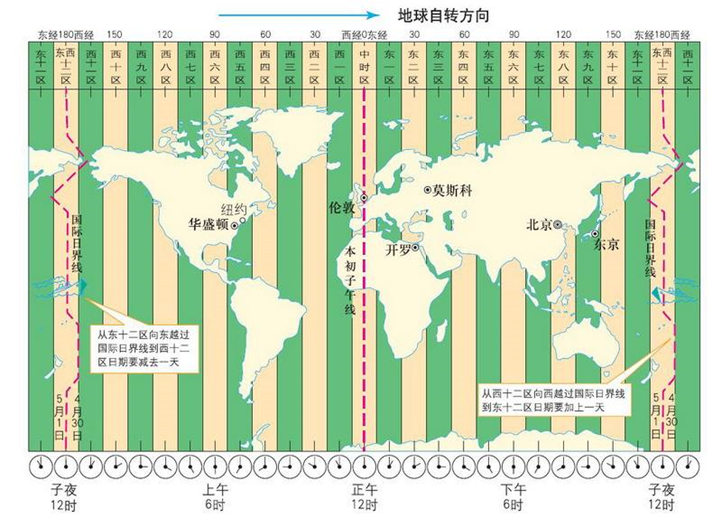
整个地球分为二十四时区,每个时区都有自己的本地时间。北京时区是东八区,领先 UTC 八个小时,在电子邮件信头的 Date 域记为 + 0800。如果在电子邮件的信头中有这么一行:
Date: Fri, 08 Nov 2002 09:42:22 +0800
说明信件的发送地的地方时间是二○○二年十一月八号,星期五,早上九点四十二分(二十二秒),这个地方的本地时领先 UTC 八个小时 (+0800, 就是东八区时间)。电子邮件信头的 Date 域使用二十四小时的时钟,而不使用 AM 和 PM 来标记上下午。
# 4.3 日期时间格式化类:DateTimeFormatter
该类提供了三种格式化方法:
(了解) 预定义的标准格式。如:ISO_LOCAL_DATE_TIME、ISO_LOCAL_DATE、ISO_LOCAL_TIME
(了解) 本地化相关的格式。如:ofLocalizedDate (FormatStyle.LONG)
// 本地化相关的格式。如:ofLocalizedDateTime ()// FormatStyle.MEDIUM/ FormatStyle.SHORT : 适用于 LocalDateTime// 本地化相关的格式。如:ofLocalizedDate ()// FormatStyle.FULL/ FormatStyle.LONG/ FormatStyle.MEDIUM/ FormatStyle.SHORT : 适用于 LocalDate自定义的格式。如:ofPattern (“yyyy-MM-dd hh:mm:ss”)
| 方 法 | 描 述 |
|---|---|
| ofPattern(String pattern) | 静态方法,返回一个指定字符串格式的 DateTimeFormatter |
| format(TemporalAccessor t) | 格式化一个日期、时间,返回字符串 |
| parse(CharSequence text) | 将指定格式的字符序列解析为一个日期、时间 |
举例:
import org.junit.Test; | |
import java.time.LocalDateTime; | |
import java.time.ZoneId; | |
import java.time.format.DateTimeFormatter; | |
import java.time.format.FormatStyle; | |
public class TestDatetimeFormatter { | |
@Test | |
public void test1(){ | |
// 方式一:预定义的标准格式。如:ISO_LOCAL_DATE_TIME;ISO_LOCAL_DATE;ISO_LOCAL_TIME | |
DateTimeFormatter formatter = DateTimeFormatter.ISO_LOCAL_DATE_TIME; | |
// 格式化:日期 --> 字符串 | |
LocalDateTime localDateTime = LocalDateTime.now(); | |
String str1 = formatter.format(localDateTime); | |
System.out.println(localDateTime); | |
System.out.println(str1);//2022-12-04T21:02:14.808 | |
// 解析:字符串 --> 日期 | |
TemporalAccessor parse = formatter.parse("2022-12-04T21:02:14.808"); | |
LocalDateTime dateTime = LocalDateTime.from(parse); | |
System.out.println(dateTime); | |
} | |
@Test | |
public void test2(){ | |
LocalDateTime localDateTime = LocalDateTime.now(); | |
// 方式二: | |
// 本地化相关的格式。如:ofLocalizedDateTime () | |
// FormatStyle.LONG/ FormatStyle.MEDIUM/ FormatStyle.SHORT : 适用于 LocalDateTime | |
DateTimeFormatter formatter1 = DateTimeFormatter.ofLocalizedDateTime(FormatStyle.LONG); | |
// 格式化 | |
String str2 = formatter1.format(localDateTime); | |
System.out.println(str2);// 2022 年 12 月 4 日 下午 09 时 03 分 55 秒 | |
// 本地化相关的格式。如:ofLocalizedDate () | |
// FormatStyle.FULL/ FormatStyle.LONG/ FormatStyle.MEDIUM/ FormatStyle.SHORT : 适用于 LocalDate | |
DateTimeFormatter formatter2 = DateTimeFormatter.ofLocalizedDate(FormatStyle.FULL); | |
// 格式化 | |
String str3 = formatter2.format(LocalDate.now()); | |
System.out.println(str3);// 2022 年 12 月 4 日 星期日 | |
} | |
@Test | |
public void test3(){ | |
// 方式三:自定义的方式(关注、重点) | |
DateTimeFormatter dateTimeFormatter = DateTimeFormatter.ofPattern("yyyy/MM/dd HH:mm:ss"); | |
// 格式化 | |
String strDateTime = dateTimeFormatter.format(LocalDateTime.now()); | |
System.out.println(strDateTime); //2022/12/04 21:05:42 | |
// 解析 | |
TemporalAccessor accessor = dateTimeFormatter.parse("2022/12/04 21:05:42"); | |
LocalDateTime localDateTime = LocalDateTime.from(accessor); | |
System.out.println(localDateTime); //2022-12-04T21:05:42 | |
} | |
} |
# 4.4 其它 API
1、指定时区日期时间:ZondId 和 ZonedDateTime
ZoneId:该类中包含了所有的时区信息,一个时区的 ID,如 Europe/Paris
ZonedDateTime:一个在 ISO-8601 日历系统时区的日期时间,如 2007-12-03T10:15:30+01:00 Europe/Paris。
- 其中每个时区都对应着 ID,地区 ID 都为 “{区域}/{城市}” 的格式,例如:Asia/Shanghai 等
常见时区 ID:
Asia/Shanghai | |
UTC | |
America/New_York |
- 可以通过 ZondId 获取所有可用的时区 ID:
import java.time.ZoneId; | |
import java.time.ZonedDateTime; | |
import java.util.Set; | |
public class TestZone { | |
@Test | |
public void test01() { | |
// 需要知道一些时区的 id | |
//Set<String > 是一个集合,容器 | |
Set<String> availableZoneIds = ZoneId.getAvailableZoneIds(); | |
// 快捷模板 iter | |
for (String availableZoneId : availableZoneIds) { | |
System.out.println(availableZoneId); | |
} | |
} | |
@Test | |
public void test02(){ | |
ZonedDateTime t1 = ZonedDateTime.now(); | |
System.out.println(t1); | |
ZonedDateTime t2 = ZonedDateTime.now(ZoneId.of("America/New_York")); | |
System.out.println(t2); | |
} | |
} |
2、持续日期 / 时间:Period 和 Duration
- 持续时间:Duration,用于计算两个 “时间” 间隔
- 日期间隔:Period,用于计算两个 “日期” 间隔
import org.junit.Test; | |
import java.time.Duration; | |
import java.time.LocalDate; | |
import java.time.LocalDateTime; | |
import java.time.Period; | |
public class TestPeriodDuration { | |
@Test | |
public void test01(){ | |
LocalDate t1 = LocalDate.now(); | |
LocalDate t2 = LocalDate.of(2018, 12, 31); | |
Period between = Period.between(t1, t2); | |
System.out.println(between); | |
System.out.println("相差的年数:"+between.getYears()); | |
System.out.println("相差的月数:"+between.getMonths()); | |
System.out.println("相差的天数:"+between.getDays()); | |
System.out.println("相差的总数:"+between.toTotalMonths()); | |
} | |
@Test | |
public void test02(){ | |
LocalDateTime t1 = LocalDateTime.now(); | |
LocalDateTime t2 = LocalDateTime.of(2017, 8, 29, 0, 0, 0, 0); | |
Duration between = Duration.between(t1, t2); | |
System.out.println(between); | |
System.out.println("相差的总天数:"+between.toDays()); | |
System.out.println("相差的总小时数:"+between.toHours()); | |
System.out.println("相差的总分钟数:"+between.toMinutes()); | |
System.out.println("相差的总秒数:"+between.getSeconds()); | |
System.out.println("相差的总毫秒数:"+between.toMillis()); | |
System.out.println("相差的总纳秒数:"+between.toNanos()); | |
System.out.println("不够一秒的纳秒数:"+between.getNano()); | |
} | |
@Test | |
public void test03(){ | |
//Duration: 用于计算两个 “时间” 间隔,以秒和纳秒为基准 | |
LocalTime localTime = LocalTime.now(); | |
LocalTime localTime1 = LocalTime.of(15, 23, 32); | |
//between (): 静态方法,返回 Duration 对象,表示两个时间的间隔 | |
Duration duration = Duration.between(localTime1, localTime); | |
System.out.println(duration); | |
System.out.println(duration.getSeconds()); | |
System.out.println(duration.getNano()); | |
LocalDateTime localDateTime = LocalDateTime.of(2016, 6, 12, 15, 23, 32); | |
LocalDateTime localDateTime1 = LocalDateTime.of(2017, 6, 12, 15, 23, 32); | |
Duration duration1 = Duration.between(localDateTime1, localDateTime); | |
System.out.println(duration1.toDays()); | |
} | |
@Test | |
public void test4(){ | |
//Period: 用于计算两个 “日期” 间隔,以年、月、日衡量 | |
LocalDate localDate = LocalDate.now(); | |
LocalDate localDate1 = LocalDate.of(2028, 3, 18); | |
Period period = Period.between(localDate, localDate1); | |
System.out.println(period); | |
System.out.println(period.getYears()); | |
System.out.println(period.getMonths()); | |
System.out.println(period.getDays()); | |
Period period1 = period.withYears(2); | |
System.out.println(period1); | |
} | |
} |
3、Clock:使用时区提供对当前即时、日期和时间的访问的时钟。
4、
TemporalAdjuster : 时间校正器。有时我们可能需要获取例如:将日期调整到 “下一个工作日” 等操作。
TemporalAdjusters : 该类通过静态方法 (firstDayOfXxx ()/lastDayOfXxx ()/nextXxx ()) 提供了大量的常用 TemporalAdjuster 的实现。
@Test | |
public void test1(){ | |
// TemporalAdjuster: 时间校正器 | |
// 获取当前日期的下一个周日是哪天? | |
TemporalAdjuster temporalAdjuster = TemporalAdjusters.next(DayOfWeek.SUNDAY); | |
LocalDateTime localDateTime = LocalDateTime.now().with(temporalAdjuster); | |
System.out.println(localDateTime); | |
// 获取下一个工作日是哪天? | |
LocalDate localDate = LocalDate.now().with(new TemporalAdjuster() { | |
@Override | |
public Temporal adjustInto(Temporal temporal) { | |
LocalDate date = (LocalDate) temporal; | |
if (date.getDayOfWeek().equals(DayOfWeek.FRIDAY)) { | |
return date.plusDays(3); | |
} else if (date.getDayOfWeek().equals(DayOfWeek.SATURDAY)) { | |
return date.plusDays(2); | |
} else { | |
return date.plusDays(1); | |
} | |
} | |
}); | |
System.out.println("下一个工作日是:" + localDate); | |
} |
# 4.5 与传统日期处理的转换
| 类 | To 遗留类 | From 遗留类 |
|---|---|---|
| java.time.Instant 与 java.util.Date | Date.from(instant) | date.toInstant() |
| java.time.Instant 与 java.sql.Timestamp | Timestamp.from(instant) | timestamp.toInstant() |
| java.time.ZonedDateTime 与 java.util.GregorianCalendar | GregorianCalendar.from(zonedDateTime) | cal.toZonedDateTime() |
| java.time.LocalDate 与 java.sql.Time | Date.valueOf(localDate) | date.toLocalDate() |
| java.time.LocalTime 与 java.sql.Time | Date.valueOf(localDate) | date.toLocalTime() |
| java.time.LocalDateTime 与 java.sql.Timestamp | Timestamp.valueOf(localDateTime) | timestamp.toLocalDateTime() |
| java.time.ZoneId 与 java.util.TimeZone | Timezone.getTimeZone(id) | timeZone.toZoneId() |
| java.time.format.DateTimeFormatter 与 java.text.DateFormat | formatter.toFormat() | 无 |
# 5. Java 比较器
我们知道基本数据类型的数据(除 boolean 类型外)需要比较大小的话,之间使用比较运算符即可,但是引用数据类型是不能直接使用比较运算符来比较大小的。那么,如何解决这个问题呢?

在 Java 中经常会涉及到对象数组的排序问题,那么就涉及到对象之间的比较问题。
Java 实现对象排序的方式有两种:
- 自然排序:java.lang.Comparable
- 定制排序:java.util.Comparator
# 5.1 自然排序:java.lang.Comparable 接口
Comparable 接口强行对实现它的每个类的对象进行整体排序。这种排序被称为类的自然排序。
实现步骤:
- 具体类 A 需要实现 Comparable 接口
- 重写接口中的 compareTo (Object obj) 方法,指明类 A 对象间的比较标准
- 创建类 A 的多个实例,进行大小比较(直接调用
compareTo())或排序(例如Arrays.sort())
实现 Comparable 的类必须实现
compareTo(Object obj)方法,两个对象即通过 compareTo (Object obj) 方法的返回值来比较大小。如果当前对象 this 大于形参对象 obj,则返回正整数,如果当前对象 this 小于形参对象 obj,则返回负整数,如果当前对象 this 等于形参对象 obj,则返回零。
package java.lang; | |
public interface Comparable{ | |
int compareTo(Object obj); | |
} |
实现 Comparable 接口的对象列表(和数组)可以通过 Collections.sort 或 Arrays.sort 进行自动排序。实现此接口的对象可以用作有序映射中的键或有序集合中的元素,无需指定比较器。
对于类 C 的每一个 e1 和 e2 来说,当且仅当 e1.compareTo (e2) == 0 与 e1.equals (e2) 具有相同的 boolean 值时,类 C 的自然排序才叫做与 equals 一致。建议(虽然不是必需的)
最好使自然排序与 equals 一致。Comparable 的典型实现:(
默认都是从小到大排列的)- String:按照字符串中字符的 Unicode 值进行比较
- Character:按照字符的 Unicode 值来进行比较
- 数值类型对应的包装类以及 BigInteger、BigDecimal:按照它们对应的数值大小进行比较
- Boolean:true 对应的包装类实例大于 false 对应的包装类实例
- Date、Time 等:后面的日期时间比前面的日期时间大
代码示例:
package com.atguigu.api; | |
public class Student implements Comparable { | |
private int id; | |
private String name; | |
private int score; | |
private int age; | |
public Student(int id, String name, int score, int age) { | |
this.id = id; | |
this.name = name; | |
this.score = score; | |
this.age = age; | |
} | |
public int getId() { | |
return id; | |
} | |
public void setId(int id) { | |
this.id = id; | |
} | |
public String getName() { | |
return name; | |
} | |
public void setName(String name) { | |
this.name = name; | |
} | |
public int getScore() { | |
return score; | |
} | |
public void setScore(int score) { | |
this.score = score; | |
} | |
public int getAge() { | |
return age; | |
} | |
public void setAge(int age) { | |
this.age = age; | |
} | |
@Override | |
public String toString() { | |
return "Student{" + | |
"id=" + id + | |
", name='" + name + '\'' + | |
", score=" + score + | |
", age=" + age + | |
'}'; | |
} | |
@Override | |
public int compareTo(Object o) { | |
// 这些需要强制,将 o 对象向下转型为 Student 类型的变量,才能调用 Student 类中的属性 | |
// 默认按照学号比较大小 | |
Student stu = (Student) o; | |
return this.id - stu.id; | |
} | |
} |
测试类
package com.atguigu.api; | |
public class TestStudent { | |
public static void main(String[] args) { | |
Student[] arr = new Student[5]; | |
arr[0] = new Student(3,"张三",90,23); | |
arr[1] = new Student(1,"熊大",100,22); | |
arr[2] = new Student(5,"王五",75,25); | |
arr[3] = new Student(4,"李四",85,24); | |
arr[4] = new Student(2,"熊二",85,18); | |
// 单独比较两个对象 | |
System.out.println(arr[0].compareTo(arr[1])); | |
System.out.println(arr[1].compareTo(arr[2])); | |
System.out.println(arr[2].compareTo(arr[2])); | |
System.out.println("所有学生:"); | |
for (int i = 0; i < arr.length; i++) { | |
System.out.println(arr[i]); | |
} | |
System.out.println("按照学号排序:"); | |
for (int i = 1; i < arr.length; i++) { | |
for (int j = 0; j < arr.length-i; j++) { | |
if(arr[j].compareTo(arr[j+1])>0){ | |
Student temp = arr[j]; | |
arr[j] = arr[j+1]; | |
arr[j+1] = temp; | |
} | |
} | |
} | |
for (int i = 0; i < arr.length; i++) { | |
System.out.println(arr[i]); | |
} | |
} | |
} |
再举例:
public class Student implements Comparable { | |
private String name; | |
private int score; | |
public Student(String name, int score) { | |
this.name = name; | |
this.score = score; | |
} | |
public String getName() { | |
return name; | |
} | |
public void setName(String name) { | |
this.name = name; | |
} | |
public int getScore() { | |
return score; | |
} | |
public void setScore(int score) { | |
this.score = score; | |
} | |
@Override | |
public String toString() { | |
return "Student{" + | |
"name='" + name + '\'' + | |
", score=" + score + | |
'}'; | |
} | |
@Override | |
public int compareTo(Object o) { | |
return this.score - ((Student)o).score; | |
} | |
} |
测试:
@Test | |
public void test02() { | |
Student[] students = new Student[3]; | |
students[0] = new Student("张三", 96); | |
students[1] = new Student("李四", 85); | |
students[2] = new Student("王五", 98); | |
System.out.println(Arrays.toString(students)); | |
Arrays.sort(students); | |
System.out.println(Arrays.toString(students)); | |
} |
再举例:
// 若想使用 Arrays.sort () 方法,需要实现 Comparable 接口,重写 compareTo () 抽象方法 | |
public class Product implements Comparable { | |
private String name; | |
private double price; | |
public Product() { | |
} | |
public Product(String name, double price) { | |
this.name = name; | |
this.price = price; | |
} | |
public String getName() { | |
return name; | |
} | |
public void setName(String name) { | |
this.name = name; | |
} | |
public double getPrice() { | |
return price; | |
} | |
public void setPrice(double price) { | |
this.price = price; | |
} | |
@Override | |
public String toString() { | |
return "Product{" + | |
"name='" + name + '\'' + | |
", price=" + price + | |
'}'; | |
} | |
/** | |
* 实现 Comparable 接口的抽象方法:compareTo (Object o) | |
* 在此方法中,指明如何比较两个对象的大小,比如按照价格从低到高排序 | |
* | |
* @param o 被比较的对象 | |
* @return 0:相等;正数:当前对象大;负数:当前对象小 | |
*/ | |
@Override | |
public int compareTo(Object o) { | |
// 判断 o 是否是 this | |
if (this == o) { | |
return 0; | |
} | |
// 判断 o 是否是 Product 类型 | |
if (o instanceof Product) { // 向下转型前的检查,避免 ClassCastException | |
Product product = (Product) o; | |
return Double.compare(this.price, product.price); | |
} | |
// 若不是 Product 类型,则抛出异常 | |
throw new RuntimeException("传入的数据类型不一致!"); | |
} | |
} |
测试:
@Test | |
public void test2() { | |
Product[] arr = new Product[5]; | |
arr[0] = new Product("lenovoMouse", 34); | |
arr[1] = new Product("dellMouse", 43); | |
arr[2] = new Product("xiaomiMouse", 12); | |
arr[3] = new Product("huaweiMouse", 65); | |
arr[4] = new Product("appleMouse", 43); | |
Arrays.sort(arr); // 前提是 Product 类实现了 Comparable 接口,并重写了 compareTo () 方法 | |
for (int i = 0; i < arr.length; i++) { | |
System.out.println(arr[i]); | |
} | |
} |
# 5.2 定制排序:java.util.Comparator 接口
- 思考
- 当元素的类型没有实现 java.lang.Comparable 接口而又不方便修改代码(例如:一些第三方的类,你只有.class 文件,没有源文件)
- 如果一个类,实现了 Comparable 接口,也指定了两个对象的比较大小的规则,但是此时此刻我不想按照它预定义的方法比较大小,但是我又不能随意修改,因为会影响其他地方的使用,怎么办?
- JDK 在设计类库之初,也考虑到这种情况,所以又增加了一个 java.util.Comparator 接口。强行对多个对象进行整体排序的比较。
- 创建一个实现 Comparator 接口的实现类 A
- 实现类 A 中重写 compare (Object o1,Object o2) 方法,指明要比较大小的对象的大小关系(比如 String 类、Product 类)。比较 o1 和 o2 的大小:如果方法返回正整数,则表示 o1 大于 o2;如果返回 0,表示相等;返回负整数,表示 o1 小于 o2
- 创建实现类 A 的实例对象,并将此对象作为参数传递给 sort 方法(如 Collections.sort () 或 Arrays.sort ()),从而允许在排序顺序上实现精确控制
package java.util; | |
public interface Comparator{ | |
int compare(Object o1,Object o2); | |
} |
举例:
package com.atguigu.api; | |
import java.util.Comparator; | |
// 定义定制比较器类 | |
public class StudentScoreComparator implements Comparator { | |
@Override | |
public int compare(Object o1, Object o2) { | |
Student s1 = (Student) o1; | |
Student s2 = (Student) o2; | |
int result = s1.getScore() - s2.getScore(); | |
return result != 0 ? result : s1.getId() - s2.getId(); | |
} | |
} |
测试类
package com.atguigu.api; | |
public class TestStudent { | |
public static void main(String[] args) { | |
Student[] arr = new Student[5]; | |
arr[0] = new Student(3, "张三", 90, 23); | |
arr[1] = new Student(1, "熊大", 100, 22); | |
arr[2] = new Student(5, "王五", 75, 25); | |
arr[3] = new Student(4, "李四", 85, 24); | |
arr[4] = new Student(2, "熊二", 85, 18); | |
System.out.println("所有学生:"); | |
for (int i = 0; i < arr.length; i++) { | |
System.out.println(arr[i]); | |
} | |
System.out.println("按照成绩排序"); | |
StudentScoreComparator sc = new StudentScoreComparator(); | |
for (int i = 1; i < arr.length; i++) { | |
for (int j = 0; j < arr.length - i; j++) { | |
if (sc.compare(arr[j], arr[j + 1]) > 0) { | |
Student temp = arr[j]; | |
arr[j] = arr[j + 1]; | |
arr[j + 1] = temp; | |
} | |
} | |
} | |
for (int i = 0; i < arr.length; i++) { | |
System.out.println(arr[i]); | |
} | |
} | |
} |
再举例:
@Test | |
public void test01() { | |
Student[] students = new Student[5]; | |
students[0] = new Student(3, "张三", 90, 23); | |
students[1] = new Student(1, "熊大", 100, 22); | |
students[2] = new Student(5, "王五", 75, 25); | |
students[3] = new Student(4, "李四", 85, 24); | |
students[4] = new Student(2, "熊二", 85, 18); | |
System.out.println(Arrays.toString(students)); | |
// 定制排序 | |
StudentScoreComparator sc = new StudentScoreComparator(); | |
Arrays.sort(students, sc); | |
System.out.println("排序之后:"); | |
System.out.println(Arrays.toString(students)); | |
} |
再举例:
Goods[] all = new Goods[4]; | |
all[0] = new Goods("War and Peace", 100); | |
all[1] = new Goods("Childhood", 80); | |
all[2] = new Goods("Scarlet and Black", 140); | |
all[3] = new Goods("Notre Dame de Paris", 120); | |
Arrays.sort(all, new Comparator() { | |
@Override | |
public int compare(Object o1, Object o2) { | |
Goods g1 = (Goods) o1; | |
Goods g2 = (Goods) o2; | |
return g1.getName().compareTo(g2.getName()); | |
} | |
}); | |
System.out.println(Arrays.toString(all)); |
# 5.3 二者对比
| 自然排序:Comparable 接口 | 定制排序:Comparator 接口 |
|---|---|
| 单一的、唯一的 | 灵活的、多样的 |
| 一劳永逸的 | 临时的 |
重写 compareTo(Object obj) 抽象方法 | 重写 compare(Object obj1,Object obj2) 抽象方法 |
| 对具体类的声明、内部进行修改 | 将实现类的实例作为参数传递给 sort () 即可 |
# 6. 系统相关类
# 6.1 java.lang.System 类
System 类代表系统,系统级的很多属性和控制方法都放置在该类的内部。该类位于
java.lang包。由于该类的构造器是 private 的,所以无法创建该类的对象。其内部的成员变量和成员方法都是
static的,所以也可以很方便的进行调用。成员变量 Scanner scan = new Scanner (System.in);
- System 类内部包含
in、out和err三个成员变量,分别代表标准输入流 (键盘输入),标准输出流 (显示器) 和标准错误输出流 (显示器)。
- System 类内部包含
成员方法
native long currentTimeMillis():
该方法的作用是返回当前的计算机时间,时间的表达格式为当前计算机时间和 GMT 时间 (格林威治时间) 1970 年 1 月 1 号 0 时 0 分 0 秒所差的毫秒数。void exit(int status):
该方法的作用是退出程序。其中 status 的值为0 代表正常退出,非零代表异常退出。使用该方法可以在图形界面编程中实现程序的退出功能等。void gc():
该方法的作用是请求系统进行垃圾回收。至于系统是否立刻回收,则取决于系统中垃圾回收算法的实现以及系统执行时的情况。String getProperty(String key):
该方法的作用是获得系统中属性名为 key 的属性对应的值。系统中常见的属性名以及属性的作用如下表所示:![image-20220406003340258]()
举例
import org.junit.Test; | |
public class TestSystem { | |
@Test | |
public void test01(){ | |
long time = System.currentTimeMillis(); | |
System.out.println("现在的系统时间距离1970年1月1日凌晨:" + time + "毫秒"); | |
System.exit(0); | |
System.out.println("over");// 不会执行 | |
} | |
@Test | |
public void test02(){ | |
String javaVersion = System.getProperty("java.version"); | |
System.out.println("java的version:" + javaVersion); | |
String javaHome = System.getProperty("java.home"); | |
System.out.println("java的home:" + javaHome); | |
String osName = System.getProperty("os.name"); | |
System.out.println("os的name:" + osName); | |
String osVersion = System.getProperty("os.version"); | |
System.out.println("os的version:" + osVersion); | |
String userName = System.getProperty("user.name"); | |
System.out.println("user的name:" + userName); | |
String userHome = System.getProperty("user.home"); | |
System.out.println("user的home:" + userHome); | |
String userDir = System.getProperty("user.dir"); | |
System.out.println("user的dir:" + userDir); | |
} | |
@Test | |
public void test03() throws InterruptedException { | |
for (int i=1; i <=10; i++){ | |
MyDemo my = new MyDemo(i); | |
// 每一次循环 my 就会指向新的对象,那么上次的对象就没有变量引用它了,就成垃圾对象 | |
} | |
// 为了看到垃圾回收器工作,我要加下面的代码,让 main 方法不那么快结束,因为 main 结束就会导致 JVM 退出,GC 也会跟着结束。 | |
System.gc();// 如果不调用这句代码,GC 可能不工作,因为当前内存很充足,GC 就觉得不着急回收垃圾对象。 | |
// 调用这句代码,会让 GC 尽快来工作。 | |
Thread.sleep(5000); | |
} | |
} | |
class MyDemo{ | |
private int value; | |
public MyDemo(int value) { | |
this.value = value; | |
} | |
@Override | |
public String toString() { | |
return "MyDemo{" + "value=" + value + '}'; | |
} | |
// 重写 finalize 方法,让大家看一下它的调用效果 | |
@Override | |
protected void finalize() throws Throwable { | |
// 正常重写,这里是编写清理系统内存的代码 | |
// 这里写输出语句是为了看到 finalize () 方法被调用的效果 | |
System.out.println(this+ "轻轻的我走了,不带走一段代码...."); | |
} | |
} |
static void arraycopy(Object src, int srcPos, Object dest, int destPos, int length):从指定源数组中复制一个数组,复制从指定的位置开始,到目标数组的指定位置结束。常用于数组的插入和删除
import org.junit.Test; | |
import java.util.Arrays; | |
public class TestSystemArrayCopy { | |
@Test | |
public void test01(){ | |
int[] arr1 = {1,2,3,4,5}; | |
int[] arr2 = new int[10]; | |
System.arraycopy(arr1,0,arr2,3,arr1.length); | |
System.out.println(Arrays.toString(arr1)); | |
System.out.println(Arrays.toString(arr2)); | |
} | |
@Test | |
public void test02(){ | |
int[] arr = {1,2,3,4,5}; | |
System.arraycopy(arr,0,arr,1,arr.length-1); | |
System.out.println(Arrays.toString(arr)); | |
} | |
@Test | |
public void test03(){ | |
int[] arr = {1,2,3,4,5}; | |
System.arraycopy(arr,1,arr,0,arr.length-1); | |
System.out.println(Arrays.toString(arr)); | |
} | |
} |
# 6.2 java.lang.Runtime 类
饿汉式的单例模式
每个 Java 应用程序(Java 进程)都有一个 Runtime 类实例,使应用程序能够与其运行的环境相连接。对应于图中的 运行时数据区 。

public static Runtime getRuntime() : 返回与当前 Java 应用程序相关的运行时对象。应用程序不能创建自己的 Runtime 类实例。
public long totalMemory() :返回 Java 虚拟机中初始化时的内存总量。此方法返回的值可能随时间的推移而变化,这取决于主机环境。默认为物理电脑内存的 1/64。
public long maxMemory() :返回 Java 虚拟机中最大程度能使用的内存总量。默认为物理电脑内存的 1/4。
public long freeMemory() :回 Java 虚拟机中的空闲内存量。调用 gc 方法可能导致 freeMemory 返回值的增加。
package com.atguigu.system; | |
public class TestRuntime { | |
public static void main(String[] args) { | |
Runtime runtime = Runtime.getRuntime(); | |
long initialMemory = runtime.totalMemory(); // 获取虚拟机初始化时堆内存总量 | |
long maxMemory = runtime.maxMemory(); // 获取虚拟机最大堆内存总量 | |
String str = ""; | |
// 模拟占用内存 | |
for (int i = 0; i < 10000; i++) { | |
str += i; | |
} | |
long freeMemory = runtime.freeMemory(); // 获取空闲堆内存总量 | |
System.out.println("总内存:" + initialMemory / 1024 / 1024 * 64 + "MB"); | |
System.out.println("总内存:" + maxMemory / 1024 / 1024 * 4 + "MB"); | |
System.out.println("空闲内存:" + freeMemory / 1024 / 1024 + "MB") ; | |
System.out.println("已用内存:" + (initialMemory-freeMemory) / 1024 / 1024 + "MB"); | |
} | |
} |
# 7. 和数学相关的类
# 7.1 java.lang.Math 类
java.lang.Math 类包含用于执行基本数学运算的方法,如初等指数、对数、平方根和三角函数。类似这样的工具类,其所有方法均为静态方法,并且不会创建对象,调用起来非常简单。
public static double abs(double a):返回 double 值的绝对值。
double d1 = Math.abs(-5); //d1 的值为 5 | |
double d2 = Math.abs(5); //d2 的值为 5 |
public static double ceil(double a):返回大于等于参数的最小的整数。
double d1 = Math.ceil(3.3); //d1 的值为 4.0 | |
double d2 = Math.ceil(-3.3); //d2 的值为 -3.0 | |
double d3 = Math.ceil(5.1); //d3 的值为 6.0 |
public static double floor(double a):返回小于等于参数最大的整数。
double d1 = Math.floor(3.3); //d1 的值为 3.0 | |
double d2 = Math.floor(-3.3); //d2 的值为 - 4.0 | |
double d3 = Math.floor(5.1); //d3 的值为 5.0 |
public static long round(double a):返回最接近参数的 long。(相当于四舍五入方法)当参数 a 取两整数中间值时,取
ceil(a)。可以这样理解:不论 a 的取值大小,最后返回值均为
Math.floor(a+0.5)。
long d1 = Math.round(5.5); //d1 的值为 6 | |
long d2 = Math.round(5.4); //d2 的值为 5 | |
long d3 = Math.round(-3.3); //d3 的值为 - 3 | |
long d4 = Math.round(-3.8); //d4 的值为 - 4 | |
long d5 = Math.round(-3.5); //d4 的值为 - 3 |
- public static double pow (double a,double b):返回 a 的 b 幂次方法
- public static double sqrt (double a):返回 a 的平方根
public static double random():返回[0,1) 的随机值- public static final double PI:返回圆周率
- public static double max (double x, double y):返回 x,y 中的最大值
- public static double min (double x, double y):返回 x,y 中的最小值
- 其它:acos,asin,atan,cos,sin,tan 三角函数
double result = Math.pow(2,31); | |
double sqrt = Math.sqrt(256); | |
double rand = Math.random(); | |
double pi = Math.PI; |
# 7.2 java.math 包
# 7.2.1 BigInteger 类
Integer 类作为 int 的包装类,能存储的最大整型值为 231-1,Long 类也是有限的,最大为 263-1。如果要表示再大的整数,不管是基本数据类型还是他们的包装类都无能为力,更不用说进行运算了。
java.math 包的 BigInteger 可以表示
不可变的任意精度的整数。BigInteger 提供所有 Java 的基本整数操作符的对应物,并提供 java.lang.Math 的所有相关方法。另外,BigInteger 还提供以下运算:模算术、GCD 计算、质数测试、素数生成、位操作以及一些其他操作。构造器
- BigInteger (String val):根据字符串构建 BigInteger 对象
方法
- public BigInteger
abs():返回此 BigInteger 的绝对值的 BigInteger。 - BigInteger
add(BigInteger val) :返回其值为 (this + val) 的 BigInteger - BigInteger
subtract(BigInteger val) :返回其值为 (this - val) 的 BigInteger - BigInteger
multiply(BigInteger val) :返回其值为 (this * val) 的 BigInteger - BigInteger
divide(BigInteger val) :返回其值为 (this /val) 的 BigInteger。整数相除只保留整数部分。 - BigInteger
remainder(BigInteger val) :返回其值为 (this % val) 的 BigInteger。 - BigInteger[]
divideAndRemainder(BigInteger val):返回包含 (this /val) 后跟 (this % val) 的两个 BigInteger 的数组。 - BigInteger
pow(int exponent) :返回其值为 (this^exponent) 的 BigInteger。
- public BigInteger
@Test | |
public void test01(){ | |
//long bigNum = 123456789123456789123456789L; | |
BigInteger b1 = new BigInteger("12345678912345678912345678"); | |
BigInteger b2 = new BigInteger("78923456789123456789123456789"); | |
//System.out.println ("和:" + (b1+b2));// 错误的,无法直接使用 + 进行求和 | |
System.out.println("和:" + b1.add(b2)); | |
System.out.println("减:" + b1.subtract(b2)); | |
System.out.println("乘:" + b1.multiply(b2)); | |
System.out.println("除:" + b2.divide(b1)); | |
System.out.println("余:" + b2.remainder(b1)); | |
} |
# 7.2.2 BigDecimal
一般的 Float 类和 Double 类可以用来做科学计算或工程计算,但在商业计算中,要求数字精度比较高,故用到 java.math.BigDecimal 类。
BigDecimal 类支持不可变的、任意精度的有符号十进制定点数。
构造器
- public BigDecimal(double val)
- public BigDecimal (String val) --> 推荐
常用方法
- public BigDecimal
add(BigDecimal augend) - public BigDecimal
subtract(BigDecimal subtrahend) - public BigDecimal
multiply(BigDecimal multiplicand) - public BigDecimal
divide(BigDecimal divisor, int scale, int roundingMode):divisor 是除数,scale 指明保留几位小数,roundingMode 指明舍入模式(ROUND_UP : 向上加 1、ROUND_DOWN : 直接舍去、ROUND_HALF_UP: 四舍五入)
- public BigDecimal
举例
@Test | |
public void test03(){ | |
BigInteger bi = new BigInteger("12433241123"); | |
BigDecimal bd = new BigDecimal("12435.351"); | |
BigDecimal bd2 = new BigDecimal("11"); | |
System.out.println(bi); | |
// System.out.println(bd.divide(bd2)); | |
System.out.println(bd.divide(bd2, BigDecimal.ROUND_HALF_UP)); | |
System.out.println(bd.divide(bd2, 15, BigDecimal.ROUND_HALF_UP)); | |
} |
# 7.3 java.util.Random 类
用于产生随机数
boolean nextBoolean(): 返回下一个伪随机数,它是取自此随机数生成器序列的均匀分布的 boolean 值。void nextBytes(byte[] bytes): 生成随机字节并将其置于用户提供的 byte 数组中。double nextDouble(): 返回下一个伪随机数,它是取自此随机数生成器序列的、在 0.0 和 1.0 之间均匀分布的 double 值。float nextFloat(): 返回下一个伪随机数,它是取自此随机数生成器序列的、在 0.0 和 1.0 之间均匀分布的 float 值。double nextGaussian(): 返回下一个伪随机数,它是取自此随机数生成器序列的、呈高斯(“正态”)分布的 double 值,其平均值是 0.0,标准差是 1.0。int nextInt(): 返回下一个伪随机数,它是此随机数生成器的序列中均匀分布的 int 值。int nextInt(int n): 返回一个伪随机数,它是取自此随机数生成器序列的、在 0(包括)和指定值(不包括)之间均匀分布的 int 值。long nextLong(): 返回下一个伪随机数,它是取自此随机数生成器序列的均匀分布的 long 值。
@Test | |
public void test04(){ | |
Random r = new Random(); | |
System.out.println("随机整数:" + r.nextInt()); | |
System.out.println("随机小数:" + r.nextDouble()); | |
System.out.println("随机布尔值:" + r.nextBoolean()); | |
} |

